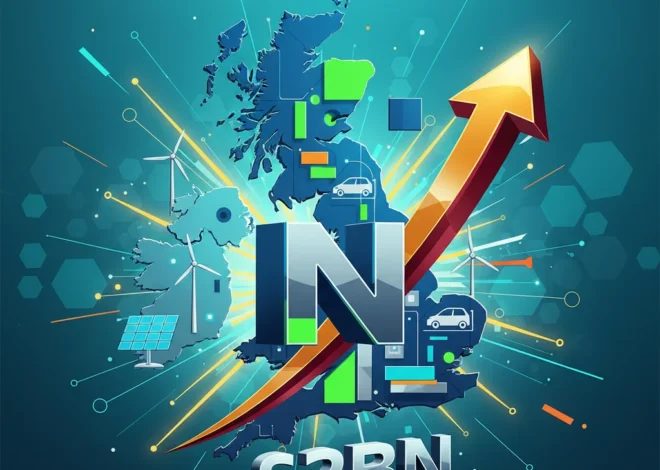
The EV Revolution: More Than a Guilt-Free Drive, It’s a Multitrillion-Dollar Economic Shift
It often starts with a simple, personal realization. For Louise Shaxson of Dorset, UK, it was the feeling of driving no longer being a “guilt trip,” a sentiment she shared in a letter to the Financial Times. This quiet, individual shift in perspective is a microcosm of one of the most profound economic and industrial transformations of our time. The move toward electric vehicles (EVs) is far more than an environmental narrative; it’s a fundamental restructuring of the global economy, a seismic event for the stock market, and a greenfield opportunity for investing and financial technology.
For over a century, the world’s financial and geopolitical landscape was built on the foundation of the internal combustion engine (ICE) and the oil that fueled it. Now, that foundation is cracking. The transition to electric mobility is re-writing the rules for legacy automakers, creating new titans of industry, and sending shockwaves through every adjacent sector, from energy and mining to banking and software. For investors, finance professionals, and business leaders, understanding the depth of this change is no longer optional—it’s critical for navigating the road ahead.
The Shifting Economics of the Driveway: Total Cost of Ownership
The initial barrier for many prospective EV buyers has been the sticker price. However, a sophisticated financial analysis looks beyond the initial outlay to the Total Cost of Ownership (TCO). This metric provides a more holistic view, encompassing purchase price, government incentives, fuel, maintenance, insurance, and depreciation. When viewed through this lens, the economic case for EVs becomes increasingly compelling.
ICE vehicles are mechanically complex, with thousands of moving parts requiring regular maintenance like oil changes, spark plug replacements, and transmission servicing. EVs, by contrast, are mechanically simpler. They have no exhaust systems, require no oil changes, and their regenerative braking systems reduce wear on brake pads. The primary “refueling” cost is electricity, which is consistently cheaper and more price-stable per mile than gasoline. According to a 2023 analysis by the U.S. Department of Energy, the cost to fuel an EV can be less than half the cost of gasoline for a comparable vehicle.
Let’s break down a hypothetical TCO comparison over five years for a mid-size sedan:
| Cost Component | Internal Combustion Engine (ICE) Vehicle | Electric Vehicle (EV) |
|---|---|---|
| Purchase Price (MSRP) | $35,000 | $45,000 |
| Government Incentives | $0 | -$7,500 |
| Net Purchase Price | $35,000 | $37,500 |
| 5-Year Fuel/Energy Costs (@12k miles/yr) | $9,000 | $3,500 |
| 5-Year Maintenance Costs | $4,500 | $1,800 |
| Estimated 5-Year TCO | $48,500 | $42,800 |
While these figures are illustrative, they reveal a crucial trend: the higher initial cost of an EV is often amortized and eventually surpassed by significant savings in fuel and maintenance. This shift has profound implications for household finance, freeing up capital that can be redirected toward consumption, savings, or investing.
The New Financial Frontier: Decoding the Fintech and Blockchain Revolution
A Macro-Economic Shockwave: Investing in a New Industrial Ecosystem
The EV transition is not merely about swapping one type of car for another; it’s a catalyst for a new industrial ecosystem. The ripple effects are redrawing the map of global supply chains and creating entirely new avenues for capital allocation. The stock market is the primary arena where this battle for the future is being waged.
Consider the core components:
- Batteries: This is the heart of the revolution. The demand for lithium, cobalt, nickel, and manganese has skyrocketed, creating a boom for mining companies and a geopolitical scramble to secure resources. Investment is pouring into battery technology research, from solid-state batteries to sodium-ion alternatives, in a race to improve energy density, reduce costs, and mitigate supply chain risks.
- Charging Infrastructure: A world of EVs requires a world of chargers. This has ignited a massive build-out of public and private charging networks, representing a multi-billion dollar opportunity for utilities, real estate owners, and specialized hardware and software companies.
- Semiconductors and Software: Modern EVs are essentially computers on wheels, running on millions of lines of code. This has made semiconductor manufacturers and software developers central players in the automotive industry, a significant departure from the mechanically-dominated ICE era.
This industrial realignment is forcing a painful but necessary transformation for legacy automakers. Companies like Ford, General Motors, and Volkswagen are committing hundreds of billions of dollars to retool factories and retrain workforces. This capital-intensive pivot is a high-stakes gamble, with investors closely watching their ability to compete with EV-native companies like Tesla. The global EV market is expected to grow from $500 billion in 2023 to nearly $1.6 trillion by 2030, a compound annual growth rate of over 18% (source), making it one of the most significant secular growth stories in modern economics.
The Fintech Frontier: When the Car Becomes a Financial Platform
The technological leap from ICE to EV is not just under the hood; it’s in the data and connectivity that define the modern vehicle. This transformation is creating a new frontier for financial technology, turning the car into a connected commerce platform.
The implications for banking and finance are vast:
- Embedded Payments: Imagine a seamless experience where your car automatically pays for charging, tolls, parking, and even your drive-thru coffee. This requires a new ecosystem of in-vehicle payment systems, a major opportunity for fintech companies and payment processors.
- Insurance Reimagined (Insurtech): EVs generate a constant stream of data about driving habits, vehicle health, and location. This allows for dynamic, usage-based insurance models that can more accurately price risk, rewarding safer drivers and lowering premiums.
- New Ownership Models: The high upfront cost and rapid technological evolution of EVs are fueling interest in subscription-based ownership models. This blurs the line between a car loan and a service contract, requiring new financial products from lenders and banking institutions.
Bitcoin in the Vault: Banking's Next Frontier or a Systemic Time Bomb?
Furthermore, the concept of the vehicle as an asset is evolving. With V2G technology, an EV owner could theoretically sell excess energy from their car’s battery back to the grid during peak demand. This creates a new micro-revenue stream, managed and optimized by sophisticated software. This level of granular, real-time energy trading is a perfect use case for automated fintech platforms, fundamentally changing the economic relationship between a person and their vehicle.
Navigating the Economic Road Ahead
The transition to electric vehicles is an unstoppable economic force. It represents one of the most significant reallocations of capital in a century, dismantling old industries while simultaneously creating new ones. For those in the world of finance, the implications are everywhere.
Portfolio managers must re-evaluate their exposure to the entire automotive and energy value chain. M&A activity will likely accelerate as legacy companies acquire tech startups to bridge their innovation gaps. Venture capitalists are funding the next generation of battery, software, and charging companies. The principles of economics are on full display as supply and demand for new commodities like lithium dictate market prices and influence international policy.
60,000 Mortgages at Risk: The Unintended Consequence of a UK Savings Overhaul
The “guilt trip” that Louise Shaxson mentioned is being eliminated not just by a cleaner tailpipe, but by a smarter, more efficient, and economically rational system of mobility. The vehicle is evolving from a simple mode of transport into a sophisticated, connected, and financially active asset. This journey is just beginning, and for those who can read the map, the investment opportunities will be transformative.
Ultimately, the quiet hum of an electric motor on a country road in Dorset is the sound of a new economic engine roaring to life. It’s a signal that the future of mobility has arrived, bringing with it a fundamental rewiring of the global financial system.


